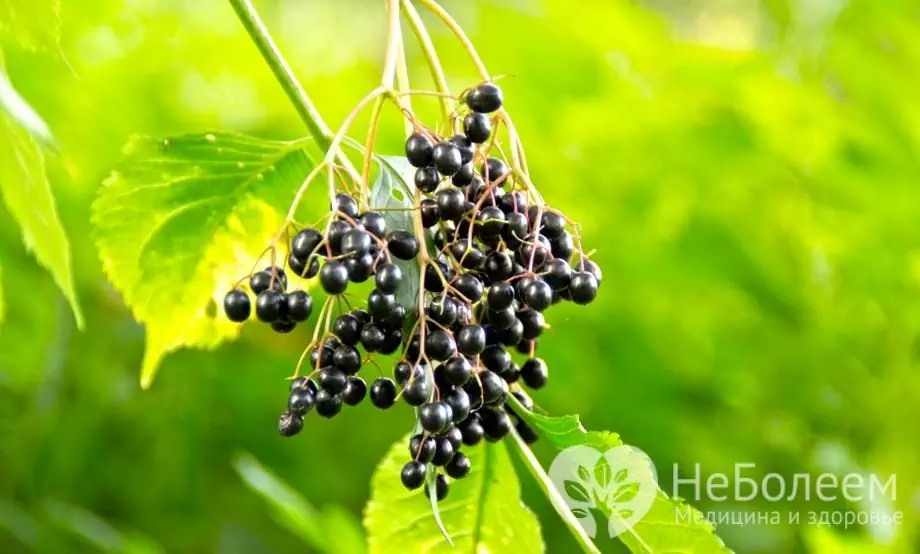- Author Rachel Wainwright [email protected].
- Public 2023-12-15 07:39.
- Last modified 2025-11-02 20:14.
Elderberry poisoning
Elderberry is a woody deciduous or herbaceous plant of the adox family, numbering about 40 species. Despite the fact that elderberry is considered an alien plant for Russia, it has become widespread throughout the country. For decorative purposes, it is grown in public gardens, parks, in personal plots. It grows wild more often in wastelands, in ravines, on the edges of forests.

Source: depositphotos.com
Elderberry is a strongly branching shrub or a short tree (on average 3-5 meters) with large, long leaves and berry-like drupes gathered in dense clusters. Depending on the species, the fruits can be of different shades from red to purple-black.
In the middle lane most often found
- black elderberry (wild bird cherry, squeak);
- red (cystic, common);
- herbaceous (smelly, undersized, canine).
Black elderberry is widely used in folk medicine as a remedy for diseases of the upper respiratory tract, urinary system, skin and joints, as well as a diaphoretic, anti-inflammatory and anti-febrile remedy.
Black elderberry is conditionally poisonous (depending on the degree of ripeness of the fruit), but the toxicity of the red and herbaceous varieties is much higher, which makes it possible to classify them as poisonous plants.
How does elderberry poisoning occur?
The danger of all parts of elderberry, with the exception of flowers and pulp of ripe berries, is due to the presence of cyanogenic glycosides sambunigrin and α-amygdalin in them. The end products of the cleavage of cyanoglycosides, after they enter the gastrointestinal tract, are ketone or aldehyde and hydrocyanic acid, the accumulation of which may lead to poisoning and toxic damage to the central nervous system.
More often, black elderberry poisoning occurs when unripe berries are eaten, ripe fruits lose their toxic properties and are absolutely safe.
Poisoning of the red and herbaceous varieties of the plant is possible when eating berries, leaves, inflorescences and young shoots, which are used in cooking and alternative medicine. Although ripe black and red elderberries can be easily distinguished by their appearance, unripe fruits are very similar.
The ingress of toxins into the body is possible through untreated hands after contact with the plant.
Elderberry can be poisoned during treatment with folk remedies made on the basis of leaves, shoots and berries of red and herbaceous elderberry.
Poisoning symptoms
When elderberry toxins enter the body, after 0.5-2 hours of the latent period, a typical clinical picture develops:
- dizziness, headache;
- sore throat;
- profuse salivation;
- nausea, vomiting, diarrhea;
- pain in the epigastrium and in the abdomen;
- increased heart rate, alternating with bradycardia;
- convulsions (rare).
Given that the cleavage of cyanoglycosides is enhanced in an alkaline environment, the symptoms of poisoning increase when the toxin from the stomach enters the duodenum.

Source: depositphotos.com
First aid for poisoning
- Psychoemotional and physical rest.
- Gastric lavage (drink 1-1.5 liters of a weak solution of potassium permanganate or a suspension of activated carbon and induce an emetic urge by pressing on the root of the tongue) to clean wash water.
- Taking a saline laxative (magnesium sulfate).
- Reception of enterosorbent (Enterosgel, Activated Carbon, Polyphepan, Polysorb MP).
When is medical attention required?
It is necessary to consult a doctor if a child has been poisoned with elderberry, because due to the functional characteristics of the child's body, the symptoms of intoxication will be more pronounced, active neurological symptoms are possible, and a lethal outcome is possible.
If an adult is poisoned with elderberry, as a rule, medical attention is not required, since the content of toxins in the plant is not large enough to develop serious health consequences. However, if after first aid there is a negative trend (deterioration) or the condition of the victim is consistently serious, it is necessary to call an ambulance team.
Possible consequences
When eating a large amount of unripe berries of black or berries of red and herbaceous elderberry, toxic damage to the central nervous system with the involvement of the vasomotor and respiratory centers can develop and subsequent death from acute heart or respiratory failure.
Prevention
To avoid elderberry poisoning, you must:
- collect elderberries only after they are fully ripe;
- use the green parts of the elderberry with caution when preparing dishes, and it is better to refuse to eat them;
- warn children about the dangers of eating shoots, leaves and berries of red and herbaceous elderberry;
- do not plant red and herbaceous elderberries for decorative purposes near playgrounds, school and preschool institutions;
- do not use elderberry during pregnancy and breastfeeding, children under 14 years old;
- with caution, take folk remedies made on the basis of elderberry, strictly following the recommendations, not exceeding the dosage and not changing the treatment regimen.

Olesya Smolnyakova Therapy, clinical pharmacology and pharmacotherapy About the author
Education: higher, 2004 (GOU VPO "Kursk State Medical University"), specialty "General Medicine", qualification "Doctor". 2008-2012 - Postgraduate student of the Department of Clinical Pharmacology, KSMU, Candidate of Medical Sciences (2013, specialty "Pharmacology, Clinical Pharmacology"). 2014-2015 - professional retraining, specialty "Management in education", FSBEI HPE "KSU".
The information is generalized and provided for informational purposes only. At the first sign of illness, see your doctor. Self-medication is hazardous to health!






